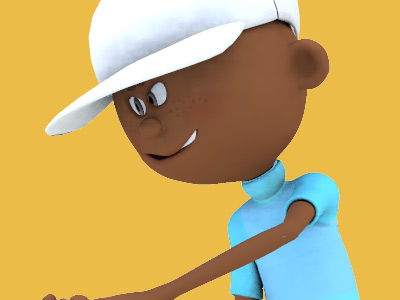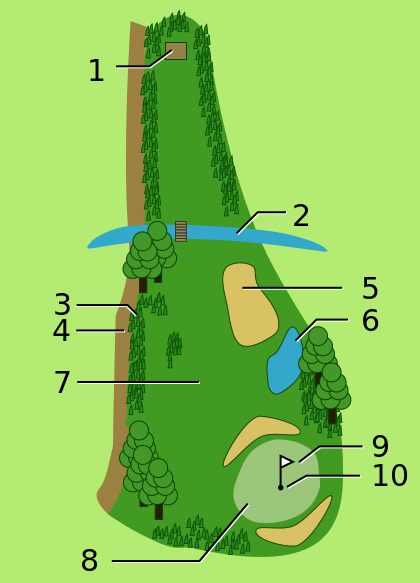Golf

Shots
List of Shots
- A drive is a long-distance shot played from the tee box, intended to move the ball a great distance down the fairway towards the green.
- An approach shot is made with the intention of placing the ball on the green. The term "approach" typically refers to a second or subsequent shot with a shorter-range iron depending on the distance required.
- A lay-up shot is made from the fairway after the drive, but intended to travel a shorter distance than might normally be expected and/or with a higher degree of accuracy, due to intervening circumstances. Most often, a lay-up shot is made to avoid hitting the ball into a hazard placed in the fairway, or to position the ball in a more favorable position on the fairway for the next shot.
- A chip is a very short shot played from near the green, generally made with an abbreviated swing motion. Chip shots are used as short approach shots to the green.
- A pitch is slightly longer than a chip shot and thus requires a slightly larger swing. It is generally hit with a lofted club and expected to stop fairly quickly once reaching the green.
- A bunker shot is a shot played from a sand trap. It is hit with a lofted wedge and is intended to hit the ball high so that it can carry over the lip of the bunker while still staying on the green.
- A flop shot is when a player opens the club face on a chip shot to get the ball to fly over an obstacle and stop quickly or spin back once it hits the ground.
- A putt is a shot designed to roll the ball along the ground. It is normally made on the putting green using a putter, though other clubs may be used to achieve the same effect in different situations. A lag is a long putt designed less to try to place the ball in the cup than to simply move the ball closer to the hole for an easier putt into the hole.
Secondary characteristics
- A draw is a stroke played with the effect that, for a right-handed player, the ball moves from right to left during flight. Conversely the ball will move from left to right for a left-handed player. These characteristics are achieved with sidespin by either an in-to-out swingpath or a closed clubface, relative to the swingpath, at impact.
- A fade is a stroke played with the effect that, for a right-handed player, the ball moves from left to right during flight. Conversely the ball will move from right to left for a left-handed player. These characteristics are achieved by having either an out-to-in swingpath or an open clubface, relative to the swingpath, at impact, again due to sidespin.
- A punch or knock-down shot is one with a low trajectory, that is employed when hitting into the wind or in order to avoid hitting the ball into overhead obstructions. This stroke is achieved by keeping the weight forward and the hands ahead of the clubhead through impact.
Misplayed shots
- A hook occurs when the clubface is closed relative to the swingpath or with an inside-out swingpath and thus flies severely from right to left for a right-handed player, or vice versa for a left-handed player. Skilled players can hook the ball at will, but most commonly it is a misplayed shot that often has negative consequences.
- A slice occurs when the clubface is open relative to the swingpath or with an outside-in swingpath and thus flies severely from left to right for a right-handed player, or vice versa for a left-handed player. Skilled players can slice the ball at will, but most commonly it is a misplayed shot that often has negative consequences.
- A push is a ball whose flight path is straight, with negligible sidespin, that ends up right of the target. The incidence angle of the clubface is x° to the right of the target, and where the path of the clubface is also x° to the right of the target (inside to outside path).
- A pull is a ball whose flight path is straight, with negligible sidespin that ends up left of the target. The incidence angle of the clubface is x° to the left of the target, and where the path of the clubface is also x° to the left of the target (outside to inside path).
- A shank occurs when the ball is struck on the hosel of the club, and thus flies at a sharp angle to the right of the intended direction (or vice versa for a left-handed player).
- A thin shot occurs when the forward edge of the clubhead strikes the ball too high, causing the shot to fly low, sometimes even causing it to travel across the ground, and usually comes up short of the target.
- A phin is an off target shot similar to a thin but it fishtails on landing.
- A top occurs when the player strikes the top half of the golf ball causing it to dribble along the ground and come up severely short of the intended target.
- A fat shot occurs when the forward edge of the clubhead strikes the ground behind the ball first, causing the shot to come up short of the target.
- A pop-up (or sky) occurs when the ball strikes too highly on the clubface, causing the shot to travel very high, leaving it well short of its intended target.
- A whiff (or air shot) occurs when the golfer swings and misses the ball.
- A duff occurs when the golfer makes contact with the top half of the ball on follow through and then it proceeds to bounce along the ground or when the golfer chunksthe golf ball causing it to bounce
Other definitions
- Backspin is imparted due to the golf club's loft and the clubhead speed at impact.
- Sidespin is imparted due to the non-perpendicularity of the golf club or the path of the clubhead.
SPORTS

RESOURCES
This article uses material from the Wikipedia articles "Golf" and "Golf stroke mechanics", which is released under the Creative Commons Attribution-Share-Alike License 3.0.
© Stories Preschool. All Rights Reserved.









